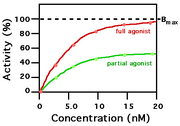(Agonist moved to Agonist (disambiguation): correct title) |
No edit summary |
||
| Line 1: | Line 1: | ||
| + | {{BioPsy}} |
||
| − | #REDIRECT [[Agonist (disambiguation)]] |
||
| + | |||
| + | |||
| + | :''For other meanings of 'agonist' or 'agonism', see [[agonism (disambiguation)]].'' |
||
| + | |||
| + | [[Image:Agonist.png|thumb|Agonists]] |
||
| + | |||
| + | In [[pharmacology]] an '''agonist''' is a substance that binds to a specific [[receptor (biochemistry)|receptor]] and triggers a response in the [[cell (biology)|cell]]. It mimics the action of an [[endogenous]] [[Ligand (biochemistry)|ligand]] (such as [[hormone]] or [[neurotransmitter]]) that binds to the same receptor. |
||
| + | |||
| + | A '''partial agonist''' (such as [[buspirone]], [[aripiprazole]], bifeprunox or nor[[clozapine]]) activates a receptor, but only produces a partial physiological response compared to a '''full agonist'''. They may also be considered as a ligand which displays both agonistic and antagonistic effects. A '''co-agonist''' works with other co-agonists to produce the desired effect together. An [[Receptor_antagonist|antagonist]] blocks a receptor from activation by agonists. |
||
| + | |||
| + | Receptors can be activated or inactivated either by endogenous (such as [[hormone]]s and [[neurotransmitter]]s) or exogenous (such as [[medication|drugs]]) agonists and antagonists, resulting in stimulating or inhibiting the cell. To see how an agonist may activate a receptor see this [http://www.bio-balance.com/Graphics.htm link]. |
||
| + | |||
| + | New findings that broaden the conventional definition of pharmacology demonstrate that ligands can concurrently behave as agonist ''and'' antagonists at the same receptor, depending on effector pathways. Terms that describe this phenomenon are "[[Functional Selectivity|functional selectivity]]" or "protean agonism".<ref>Kenakin T. (2001). Inverse, protean, and ligand-selective agonism: matters of receptor conformation. ''FASEB J.'' 15:598-611. PMID 11259378. [http://www.fasebj.org/cgi/content/full/15/3/598 Fulltext]</ref><ref>Urban J.D. et al. (2007). Functional selectivity and classical concepts of quantitative pharmacology. ''J. Pharmacol. Exp. Ther. 320:1-13. PMID 16803859.</ref> |
||
| + | |||
| + | ==Etymology== |
||
| + | From the [[Ancient Greek language|Greek]] '''αγωνιστής''' (agōnistēs), contestant; champion; rival < '''αγων''' (agōn), contest, combat; exertion, struggle < '''αγω''' (agō), I lead, lead towards, conduct; drive |
||
| + | |||
| + | ==See also== |
||
| + | * [[Inverse agonist]] |
||
| + | * [[Receptor antagonist]] |
||
| + | * [[Excitatory postsynaptic potential]] |
||
| + | * [[Allosteric modulator]] |
||
| + | * [[Intrinsic activity]] |
||
| + | |||
| + | ==References== |
||
| + | <div class="references-small"> |
||
| + | <references /> |
||
| + | </div> |
||
| + | |||
| + | [[Category:Biomolecules]] |
||
| + | [[Category:Chemical bonding]] |
||
| + | [[Category:Proteins]] |
||
| + | [[Category:Hormones]] |
||
| + | [[Category:Neurotransmitters]] |
||
| + | [[Category:Medical terms]] |
||
| + | [[Category:Pharmacology]] |
||
| + | [[Category:Physiology]] |
||
| + | |||
| + | |||
| + | <!-- |
||
| + | [[ca:Agonista]] |
||
| + | [[da:Agonist]] |
||
| + | [[de:Agonist (Pharmakologie)]] |
||
| + | [[es:Agonista]] |
||
| + | [[fr:Agoniste (biochimie)]] |
||
| + | [[ja:アゴニスト]] |
||
| + | [[pl:Agonista]] |
||
| + | [[ru:Агонист]] |
||
| + | [[sl:Agonist]] |
||
| + | [[sr:Агониста]] |
||
| + | [[fi:Agonisti]] |
||
| + | [[sv:Agonist]] |
||
| + | [[th:อะโกนิสต์]] |
||
| + | [[tr:Agonist]] |
||
| + | --> |
||
| + | {{enWP|Agonist}} |
||
Revision as of 10:08, 17 July 2007
Assessment |
Biopsychology |
Comparative |
Cognitive |
Developmental |
Language |
Individual differences |
Personality |
Philosophy |
Social |
Methods |
Statistics |
Clinical |
Educational |
Industrial |
Professional items |
World psychology |
Biological: Behavioural genetics · Evolutionary psychology · Neuroanatomy · Neurochemistry · Neuroendocrinology · Neuroscience · Psychoneuroimmunology · Physiological Psychology · Psychopharmacology (Index, Outline)
- For other meanings of 'agonist' or 'agonism', see agonism (disambiguation).

Agonists
In pharmacology an agonist is a substance that binds to a specific receptor and triggers a response in the cell. It mimics the action of an endogenous ligand (such as hormone or neurotransmitter) that binds to the same receptor.
A partial agonist (such as buspirone, aripiprazole, bifeprunox or norclozapine) activates a receptor, but only produces a partial physiological response compared to a full agonist. They may also be considered as a ligand which displays both agonistic and antagonistic effects. A co-agonist works with other co-agonists to produce the desired effect together. An antagonist blocks a receptor from activation by agonists.
Receptors can be activated or inactivated either by endogenous (such as hormones and neurotransmitters) or exogenous (such as drugs) agonists and antagonists, resulting in stimulating or inhibiting the cell. To see how an agonist may activate a receptor see this link.
New findings that broaden the conventional definition of pharmacology demonstrate that ligands can concurrently behave as agonist and antagonists at the same receptor, depending on effector pathways. Terms that describe this phenomenon are "functional selectivity" or "protean agonism".[1][2]
Etymology
From the Greek αγωνιστής (agōnistēs), contestant; champion; rival < αγων (agōn), contest, combat; exertion, struggle < αγω (agō), I lead, lead towards, conduct; drive
See also
- Inverse agonist
- Receptor antagonist
- Excitatory postsynaptic potential
- Allosteric modulator
- Intrinsic activity
References
- ↑ Kenakin T. (2001). Inverse, protean, and ligand-selective agonism: matters of receptor conformation. FASEB J. 15:598-611. PMID 11259378. Fulltext
- ↑ Urban J.D. et al. (2007). Functional selectivity and classical concepts of quantitative pharmacology. J. Pharmacol. Exp. Ther. 320:1-13. PMID 16803859.
| This page uses Creative Commons Licensed content from Wikipedia (view authors). |